An Evaluation of the Development Performance of Small County Towns and Its Influencing Factors: A Case Study of Small Towns in Jiangyin City in the Yangtze River Delta, China
Abstract
1. Introduction
2. Materials and Methods
2.1. Study Area
2.2. Data Source and Processing
2.3. Methods
2.3.1. DPSIR-DEA Model
2.3.2. Geographical Detector Model
3. Results and Analysis
3.1. Evaluation of the Development Performance of Small Towns
3.1.1. Construction of the Index System and Weight Analysis
3.1.2. Analysis of Development Performance Trends
3.1.3. Spatiotemporal Evolution of Development Performance
3.2. Factors Influencing the Development Performance of Small Towns
3.2.1. Analysis of Factor Detection Results
3.2.2. Analysis of Interactive Detection Results
4. Discussion
4.1. Reliability of Research Results
4.2. Factors Influencing the Development Performance of Small Towns
4.3. Policy Recommendations
5. Conclusions
Author Contributions
Funding
Institutional Review Board Statement
Informed Consent Statement
Data Availability Statement
Conflicts of Interest
References
- Zhang, H.Y. Exploring a new model of small town construction in southern Jiangsu. Chin. Mark. 2015, 35, 231–232. [Google Scholar] [CrossRef]
- Binns, T.; Nel, E. The village in a game park: Local response to the demise of coal mining in KwaZulu-Natal, South Africa. Econ. Geogr. 2003, 79, 41–66. [Google Scholar] [CrossRef]
- Guin, D. Contemporary perspectives of small towns in India: A review. Habitat Int. 2019, 86, 19–27. [Google Scholar] [CrossRef]
- Malý, J. Small towns in the context of “borrowed size” and “agglomeration shadow” debates: The case of the south moravian region (Czech Republic). Eur. Countrys. 2016, 8, 333–350. [Google Scholar] [CrossRef]
- David, Q.; Peeters, D.; van Hamme, G.; Vandermotten, C. Is bigger better? Economic performances of European cities, 1960–2009. Cities 2013, 35, 237–254. [Google Scholar] [CrossRef]
- Shi, Y. New-type urbanization and small town development in China. Econ. Geogr. 2013, 33, 47–52. [Google Scholar] [CrossRef]
- Wu, Q.B.; Xu, W. The theoretical logic of the transformation of the traditional town to the special small-town in the context of urban society. Econ. Geogr. 2018, 2, 82–89. [Google Scholar] [CrossRef]
- Shi, Y.S. The balanced urbanization mode of Germany and the system bottlenecks of development of Chinese small towns. Econ. Geogr. 2015, 11, 54–60. [Google Scholar] [CrossRef]
- Brenner, N. Theses on Urbanization. Public Cult. 2013, 25, 85–114. [Google Scholar] [CrossRef]
- Noronha, T.; Vaz, E. Framing urban habitats: The small and medium towns in the peripheries. Habitat Int. 2015, 45, 147–155. [Google Scholar] [CrossRef]
- Zhou, T.; Jiang, G.; Zhang, R.; Zheng, Q.; Ma, W.; Zhao, Q.; Li, Y. Addressing the rural in situ urbanization (RISU) in the Beijing–Tianjin–Hebei region: Spatio–temporal pattern and driving mechanism. Cities 2018, 75, 59–71. [Google Scholar] [CrossRef]
- Yin, X.; Wang, J.; Li, Y.R.; Feng, Z.M.; Wang, Q.Y. Are small towns really inefficient? A data envelopment analysis of sampled towns in Jiangsu province, China. Land Use Policy 2021, 109, 105590. [Google Scholar] [CrossRef]
- Yang, X.J. China’s rapid urbanization. Science 2013, 342, 310. [Google Scholar] [CrossRef]
- The Central Committee of the Communist Party of China (CPC); The State Council. National New-Type Urbanization Plan (2014–2020). Available online: http://www.gov.cn/gongbao/content/2014/content_2644805.htm (accessed on 8 July 2022).
- Chen, M.X.; Liu, W.D.; Lu, D.D. Challenges and the way forward in China’s new-type urbanization. Land Use Policy 2016, 55, 334–339. [Google Scholar] [CrossRef]
- Hasan, A. ROI calculations for electronic performance support systems. Perform. Improv. 2002, 41, 12–22. [Google Scholar] [CrossRef]
- Noori, S.; Bagherpour, M.; Zorriasatine, F. Designing a control mechanism for production planning problems by means of earned value analysis. J. Appl. Sci. 2008, 8, 3221–3227. [Google Scholar] [CrossRef][Green Version]
- Albert, P.C.; Ada, P.L. Key performance indicators for measuring construction success. Benchmarking 2004, 11, 203–221. [Google Scholar] [CrossRef]
- Andersen, E.S.; Jessen, S.A. Project evaluation scheme: A tool for evaluating project status and projecting project results. Proj. Manag. J. 2000, 6, 61–69. [Google Scholar]
- Lawrence, D.; Houghton, J.; George, A. International comparisons of Australia’s infrastructure performance. J. Prod. Anal. 1997, 8, 361–378. [Google Scholar] [CrossRef]
- Prowle, M.; Kalar, M.; Barrow, L. New development: Value for money (VFM) in public services—The importance of organizational culture. Public Money Manag. 2016, 36, 547–552. [Google Scholar] [CrossRef][Green Version]
- Shen, L.Y.; Ren, Y.T.; Xiong, N.; Li, H.; Chen, Y. Why small towns can not share the benefits of urbanization in China? J. Clean. Prod. 2018, 174, 728–738. [Google Scholar] [CrossRef]
- Zhang, Z.F.; Liu, J.; Gu, X.K. Reduction of industrial land beyond urban development boundary in Shanghai: Differences in policy responses and impact on towns and villages. Land Use Policy 2019, 82, 620–630. [Google Scholar] [CrossRef]
- Senetra, A.; Szarek-Iwaniuk, P. Socio-economic development of small towns in the Polish Cittaslow Network—A case study. Cities 2020, 103, 102758. [Google Scholar] [CrossRef]
- Ahac, M.; Ahac, S.; Devald, M.; Bezina, S. Analysis of the functional efficiency of small town arterial thoroughfare (Case study of Našice Town). Transport. Res. Procedia 2020, 45, 242–249. [Google Scholar] [CrossRef]
- Rosca, M.; Oprea, C.; Petrescu, R.; Burciu, S.; Stere, A. Improving safety and traffic conditions on national roads passing through towns without bypass. Procedia Manuf. 2020, 46, 217–224. [Google Scholar] [CrossRef]
- Brownea, S.; Linterna, A.; Jamali, B.; Leitãoc, J.P.; Bachcda, P.M. Stormwater management impacts of small urbanising towns: The necessity of investigating the ‘devil in the detail’. Sci. Total. Environ. 2021, 757, 143835. [Google Scholar] [CrossRef]
- Sircar, S. “You can call it a Mufassil town, but nothing less”: Worlding the new census towns of India. Geoforum 2018, 91, 216–226. [Google Scholar] [CrossRef]
- Guan, C.H.; Rowe, P.G. The concept of urban intensity and China’s townization policy: Cases from Zhejiang Province. Cities 2016, 55, 22–41. [Google Scholar] [CrossRef]
- Dong, L.; Du, R.; Kahn, M.; Ratti, C.; Zheng, S.Q. “Ghost cities” versus boom towns: Do China’s high-speed rail new towns thrive? Reg. Sci. Urban Econ. 2021, 89, 103682. [Google Scholar] [CrossRef]
- Huang, A.; Xu, Y.Q.; Liu, C.; Lu, L.H.; Zhang, Y.B.; Sun, P.L.; Zhou, G.Y.; Du, T.; Xiang, Y. Simulated town expansion under ecological constraints: A case study of Zhangbei County, Heibei Province, China. Habitat Int. 2019, 91, 101986. [Google Scholar] [CrossRef]
- Liao, P.; Gu, N.; Yu, R.R.; Brisbin, C. Exploring the spatial pattern of historic Chinese towns and cities: A syntactical approach. Front. Archit. Res. 2021, 10, 598–613. [Google Scholar] [CrossRef]
- Leeuwen, E.S. Urban-Rural Interactions—Towns as Focus Points in Rural Development, 5th ed.; Physica Heidelberg: Berlin, Germany, 2010; pp. 79–113. [Google Scholar] [CrossRef]
- He, S.Y.; Wu, D.; Chen, H.W.; Hou, Y.T.; Ng, M.K. New towns and the local agglomeration economy. Habitat Int. 2020, 98, 102153. [Google Scholar] [CrossRef]
- Xu, X.Y.; Le, T.H.; Kwek, A.; Wang, Y. Exploring cultural tourist towns: Does authenticity matter? Tour. Manag. Perspect. 2022, 41, 100935. [Google Scholar] [CrossRef]
- Lovell, S.A.; Gray, A.; Boucher, S.E. Economic marginalization and community capacity: How does industry closure in a small town affect perceptions of place? J. Rural Stud. 2018, 62, 107–115. [Google Scholar] [CrossRef]
- Atkinson, R. ESPON TOWN—Small and Medium Sized Towns in Their Functional Territorial Context, 3rd ed.; ESPON & University of Leuven: Leuven, Belgium, 2013; pp. 14–24. [Google Scholar]
- Yang, C.Y.; Huang, J.; Lin, Z.B.; Zhang, D.X.; Zhu, Y.; Xu, X.H.; Chen, M. Evaluating the symbiosis status of tourist towns: The case of Guizhou Province, China. Ann. Tour. Res. 2018, 72, 109–125. [Google Scholar] [CrossRef]
- Taecharungroj, V.; Boonchaiyapruek, P.; Muthuta, M. Three-pronged sustainability assessment of ten towns in the vicinity of Bangkok, Thailand. Environ. Sustain. Indic. 2019, 3, 100006. [Google Scholar] [CrossRef]
- Liu, Q.; Browne, A.L.; Lossifova, D. A socio-material approach to resource consumption and environmental sustainability of tourist accommodations in a Chinese hot spring town. Sustain. Prod. Consump. 2022, 30, 424–437. [Google Scholar] [CrossRef]
- Miao, J.T.; Phelps, N.A. “Featured town” fever: The anatomy of a concept and its elevation to national policy in China. Habitat Int. 2019. 87, 44–53. [CrossRef]
- Kijkasiwat, P.; Wellalage, N.H.; Locke, S. The impact of symbiotic relations on the performance of micro, small and medium enterprises in a small-town context: The perspective of risk and return. Res. Int. Bus. Financ. 2021, 56, 101388. [Google Scholar] [CrossRef]
- Bayulgen, O. Localizing the energy transition: Town-level political and socio-economic drivers of clean energy in the United States. Energy Res. Soc. Sci. 2020, 62, 101376. [Google Scholar] [CrossRef]
- Caselli, B.; Ventura, P.; Zazzi, M. Performance-based spatial monitoring. An interpretative model for long-term shrinking medium-small Italian towns. Sustain. Cities Soc. 2020, 53, 101924. [Google Scholar] [CrossRef]
- Xiao, W.; Wang, P. Comparative analysis to the efficiency between urban economic growth and urbanization in China. Urban. Probl. 2011, 2, 12–16. [Google Scholar] [CrossRef]
- Zhou, Z.H. Research on the Evolution and Performance Evaluation of the Industrial System in the Guangdong-Hong Kong-Macao Greater Bay Area—Based on Entropy and Improved Gravity Model Analysis. Available online: https://cpfd.cnki.com.cn/Article/CPFDTOTAL-ZHCG202109034111.htm (accessed on 8 July 2022). [CrossRef]
- Wu, C.Q.; Huang, L. Research on the performance and the synergistic effect of green development of Yangtze River Economic Belt’s industry. J. Chin Univ. Geosci. 2018, 3, 46–55. [Google Scholar] [CrossRef]
- Zhang, M.D.; Zhou, L.; Yang, X. The time-space measurement of urbanization efficiency and provincial differences. Econ. Geogr. 2012, 10, 42–48. [Google Scholar] [CrossRef]
- You, J.S.; Jiang, B.; Li, Z.J. Development efficiency evaluation and spatial pattern analysis of Beijing-Tianjin-Hebei urban agglomeration. World. Surv. Res. 2022, 4, 26–38. [Google Scholar] [CrossRef]
- Ren, Y.F.; Fang, C.L. Spatial pattern and evaluation of eco-efficiency in counties of the Beijing-Tianjin-Hebei Urban Agglomeration. Prog. Geogr. 2017, 1, 87–98. [Google Scholar] [CrossRef][Green Version]
- Guo, Y.H.; Mei, L.; Tong, L.J. The effect of industrial agglomeration on green development efficiency in restricted development zone of Jilin Province. Sci. Geogr. Sin. 2020, 9, 1484–1492. [Google Scholar] [CrossRef]
- Guo, B.; Wan, P.; Hu, J.Y. Research on performance of infrastructure investment of the pilot small towns in Xi’an. Chin. Master. Data 2014, 5, 98–101. [Google Scholar] [CrossRef]
- Lin, Q.S.; Liu, H.P.; Zhang, A.L. A case study of efficiency of land sprawl in small towns. Sci. Technol. Manag. Res. 2006, 1, 8–12. [Google Scholar] [CrossRef]
- Wu, J.L. Efficiency issues and policy options facing urbanization in China. New Financ. 2012, 11, 4–7. [Google Scholar] [CrossRef]
- Fei, X. Efficiency improvement of Chinese new type urbanization. J. Univ. Hum. Soc. Sci. 2015, 4, 50–56. [Google Scholar] [CrossRef]
- Huang, Y.; Li, L. A comprehensive assessment of green development and its spatial-temporal evolution in urban agglomerations of China. Geogr. Res. 2017, 7, 1309–1322. [Google Scholar] [CrossRef]
- Geng, H.; Shi, E.P.; Wang, L.Z.; Xie, R.; Yu, B.J. Evaluation of the development efficiency of small towns around metropolis based on GIS-DEA: Taking Wuhan as an example. Econ. Geogr. 2018, 10, 72–79. [Google Scholar] [CrossRef]
- Guo, T.Y.; Xu, Y.; Wang, Z.Q. The analyses of metropolitan efficiencies and their changes in China based on DEA and Malmquist index models. Acta Geogr. Sin. 2009, 4, 408–416. [Google Scholar] [CrossRef]
- Fan, G.; Hu, C.M. A clear strategic shift from “development of small cities and towns” to “urbanization”. J. Shenzhen Univ. Humanit. Soc. Sci. 2017, 3, 17–20. [Google Scholar] [CrossRef]
- Tian, X.Y. What is the connotation of urbanization in China? Popul. J. 2013, 6, 5–10. [Google Scholar] [CrossRef]
- Zhang, Q. The research on evaluation performance of an enterprise based on orientation of development. China. J. Manag. Sci. 2001, 2, 1893–1896. [Google Scholar] [CrossRef]
- Sun, D.Q.; Lu, J.Y.; Zhang, M.D.; Niu, F.Q. Evaluation of service function of small towns in China from the perspective of borrowed size and agglomeration shadow: A case study of southern Jiangsu Province. Prog. Geogr. 2022, 2, 199–213. [Google Scholar] [CrossRef]
- Resource and Environment Science and Data Center. Land Use Remote Sensing Monitoring Data of China. Available online: https://www.resdc.cn/Datalist1.aspx?FieldTyepID=1,3 (accessed on 8 July 2022).
- Resource and Environment Science and Data Center. Spatial Distribution Data of Elevation (DEM) in China. Available online: https://www.resdc.cn/data.aspx?DATAID=217 (accessed on 8 July 2022).
- Resource and Environment Science and Data Center. China Township Administrative Boundary Data. Available online: https://www.resdc.cn/data.aspx?DATAID=203 (accessed on 8 July 2022).
- Resource and Environment Science and Data Center. Spatial Distribution Data Set of Chinese Water System Basins. Available online: https://www.resdc.cn/Datalist1.aspx?FieldTyepID=24,14 (accessed on 8 July 2022).
- Yang, J.L.; Dong, J.W.; Xiao, X.M. Divergent shifts in peak photosynthesis timing of temperate and alpine grasslands in China. Remote Sens. Environ. 2019, 233, 111395. [Google Scholar] [CrossRef]
- Jiangyin Statistics Bureau. Jiangyin Statistical Yearbook (2001–2019); China Statistics Press: Beijing, China, 2021. [Google Scholar]
- Gari, S.R.; Newton, A.; Icely, I.D. A review of the application and evolution of the DPSIR framework with an emphasis on coastal social-ecological systems. Ocean. Coast. Manag. 2015, 103, 63–77. [Google Scholar] [CrossRef]
- Ehara, M.; Hyakumura, K.; Sato, R.; Kurosawa, K.; Araya, K.; Sokh, H.; Kohsaka, R. Addressing maladaptive coping strategies of local communities to changes in ecosystem service provisions using the DPSIR framework. Ecol. Econ. 2018, 149, 226–238. [Google Scholar] [CrossRef]
- Cui, X.Y.; Fang, L.; Wang, X.R.; Kang, J.F. Urban eco-security assessment in the urban agglomerations based on DPSIR model: A case study of Yangtze River Delta, China. Acta Ecol. Sin. 2021, 1, 302–319. [Google Scholar] [CrossRef]
- Goto, M.; Otsuka, A.; Sueyoshi, T. DEA (data envelopment analysis) assessment of operational and environmental efficiencies on Japanese regional industries. Energy 2014, 66, 535–549. [Google Scholar] [CrossRef]
- Yang, Q.S.; Zhang, Y.; Li, Y.J. Research on environmental efficiency evaluation of urban agglomerations in northeast China based on DEA model. Eco. Geogr. 2012, 9, 51–55. [Google Scholar] [CrossRef]
- Hu, Y.G.; Liao, C.Q.; Zhang, X.M.; Wang, C. DEA-Based evaluation on coordinated development efficiency of urban and rural areas. City Plan. Rev. 2016, 2, 46–50. [Google Scholar] [CrossRef]
- Wang, H.F.; Shi, Y.S.; Yin, C.Y. Land use efficiencies and their changes of Shanghai’s development zones employing DEA model and Malmquist productivity index. Geogr. Res. 2014, 9, 1636–1646. [Google Scholar] [CrossRef]
- Wang, J.F.; Xu, C.D. Geodetector: Principle and prospective. Acta Geogr. Sin. 2017, 1, 116–134. [Google Scholar] [CrossRef]
- Wang, J.F.; Li, X.H.; Christakos, G.; Liao, Y.L.; Zhang, T.; Gu, X.; Zheng, X.Y. Geographical detectors-based on health risk assessment and its application in the neural tube defects study of the Heshun region, China. Int. J. Geogr. Inf. Sci. 2010, 24, 107–127. [Google Scholar] [CrossRef]
- Yin, S.G.; Ma, Z.F.; Wu, X.Y.; Li, Z.J. Spatial-temporal differentiation and influence mechanism of the urban housing price-to-rent ratio in China. Resour. Environ. Yangtze Val. 2020, 3, 547–556. [Google Scholar] [CrossRef]
- Zhang, R.T.; Jiao, H.F. Measurement and spatial correlation pattern of urbanization efficiency in the Yangtze River Delta. Sci. Geogr. Sin. 2015, 4, 433–439. [Google Scholar] [CrossRef]
- Xiong, X.; Duan, Y.J.; Fu, W.Y.; Xiao, J. Evaluation of urbanization efficiency of urban agglomeration in the middle reaches of Yangtze River and its spatio-temporal differentiation characteristic. Econ. Geogr. 2021, 3, 105–112. [Google Scholar] [CrossRef]
- Fang, C.L.; Guan, X.L. Comprehensive measurement and spatial distinction of input-output efficiency of urban agglomerations in China. Acta Geogr. Sin. 2011, 8, 1011–1022. [Google Scholar] [CrossRef]
- Liu, Y.; Yang, J.L.; Liang, Y. The green development efficiency and equilibrium features of urban agglomerations in China. Econ. Geogr. 2019, 2, 110–117. [Google Scholar] [CrossRef]
- Hong, Y.X.; Sun, N.H. Sustainable agricultural development in areas with developed township enterprises—An analysis in the context of southern Jiangsu Province. Macro Econ. 2000, 4, 26–32. [Google Scholar] [CrossRef]
- Li, J.; Lewis, J.; Rowland, J.; Tappan, G.; Tieszen, L.L. Evaluation of land performance in Senegal using multi-temporal NDVI and rainfall series. J. Arid. Environ. 2004, 59, 463–480. [Google Scholar] [CrossRef]
- Luo, X.L.; Zhang, J.X.; Jiang, X.F. The flux of southern Jiangsu model and town development. Urban Plan. Rev. 2000, 5, 40–79. [Google Scholar] [CrossRef]
- Office of the People’s Government of Jiangyin City. Outline of the Thirteenth Five-Year Plan for the National Economic and Social Development of Jiangyin (2015–2020). Available online: http://www.jiangyin.gov.cn/doc/2016/04/01/399167.shtml (accessed on 8 July 2022).
- Xu, J.; Gu, R.X.; Wang, C.M.; Xu, S.H. Coordinated development of industrialization and urbanization in prefectural region—A case study of Jiangyin. Mod. Urban. Res. 2018, 7, 86–93. [Google Scholar] [CrossRef]
- Chen, Y.; Huang, X.J.; Zhang, L.J.; Peng, B.Z. Research on a criteria system of sustainable evaluation of planning and development for recycling economic small town: A case on Xinqiao, Jiangyin City. Econ. Geogr. 2006, 1, 74–77. [Google Scholar] [CrossRef]
- Hu, X.H.; Wu, Q.B.; Xu, W.; Li, Y.W. Specialty towns in China: Towards a typological policy approach. Land Use Policy 2022, 114, 105933. [Google Scholar] [CrossRef]
- Hu, X.H.; Xu, W.; Miao, J.T. Think locally, act locally: A critique of China’s specialty town program in practice. Geogr. Rev. 2021, 111, 393–414. [Google Scholar] [CrossRef]
- Gu, C.L.; Li, Y.; Han, S.S. Development and transition of small towns in rural China. Habitat Int. 2015, 50, 110–119. [Google Scholar] [CrossRef]
- Xu, X. Division of powers between the three levels of the German governments and the financial expenditure. China State Financ. 2009, 17, 63–64. [Google Scholar] [CrossRef]
- Shimizutani, S. Local government in Japan: New directions in governance toward citizens’ autonomy. Asia Pac. Rev. 2015, 17, 99–117. [Google Scholar] [CrossRef]
- Han, S.S. Urban expansion in contemporary China: What can we learn from a small town? Land Use Policy 2010, 27, 780–787. [Google Scholar] [CrossRef]
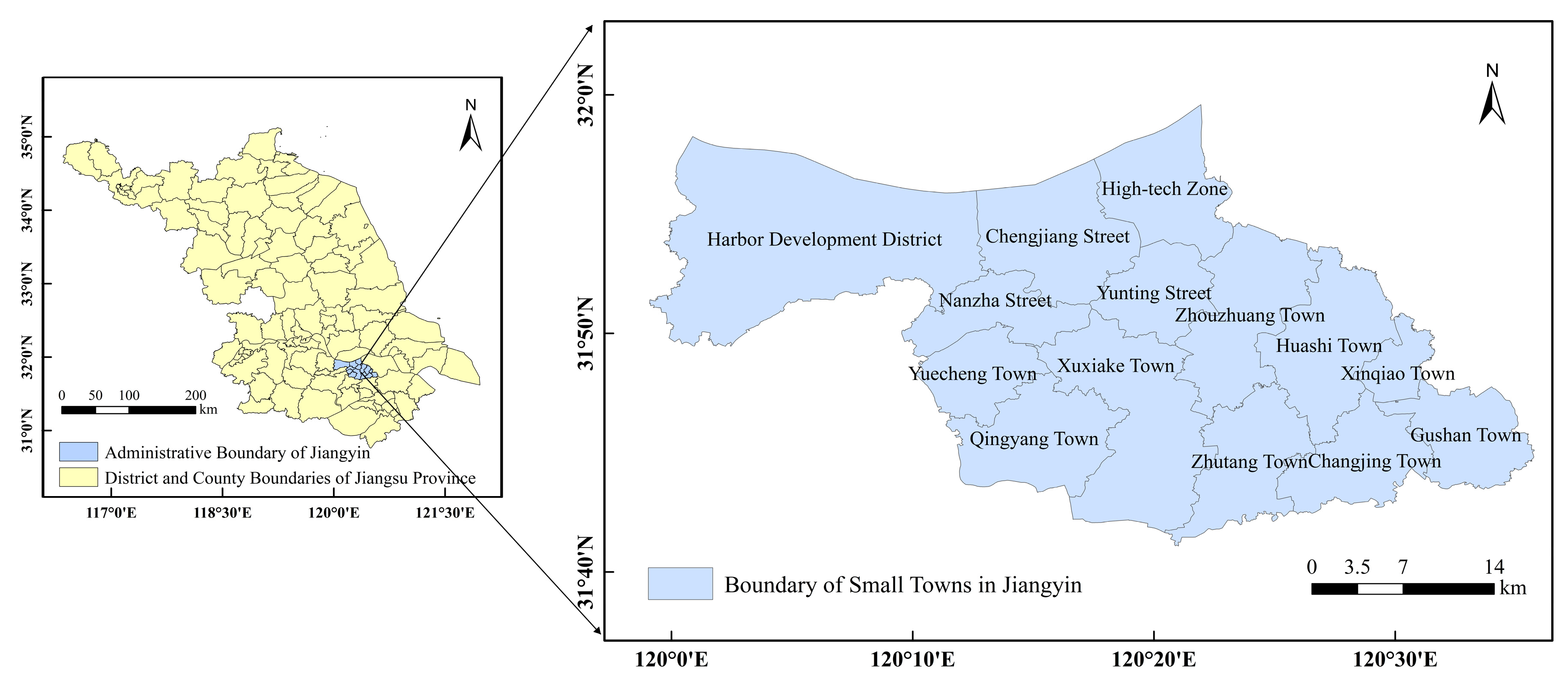
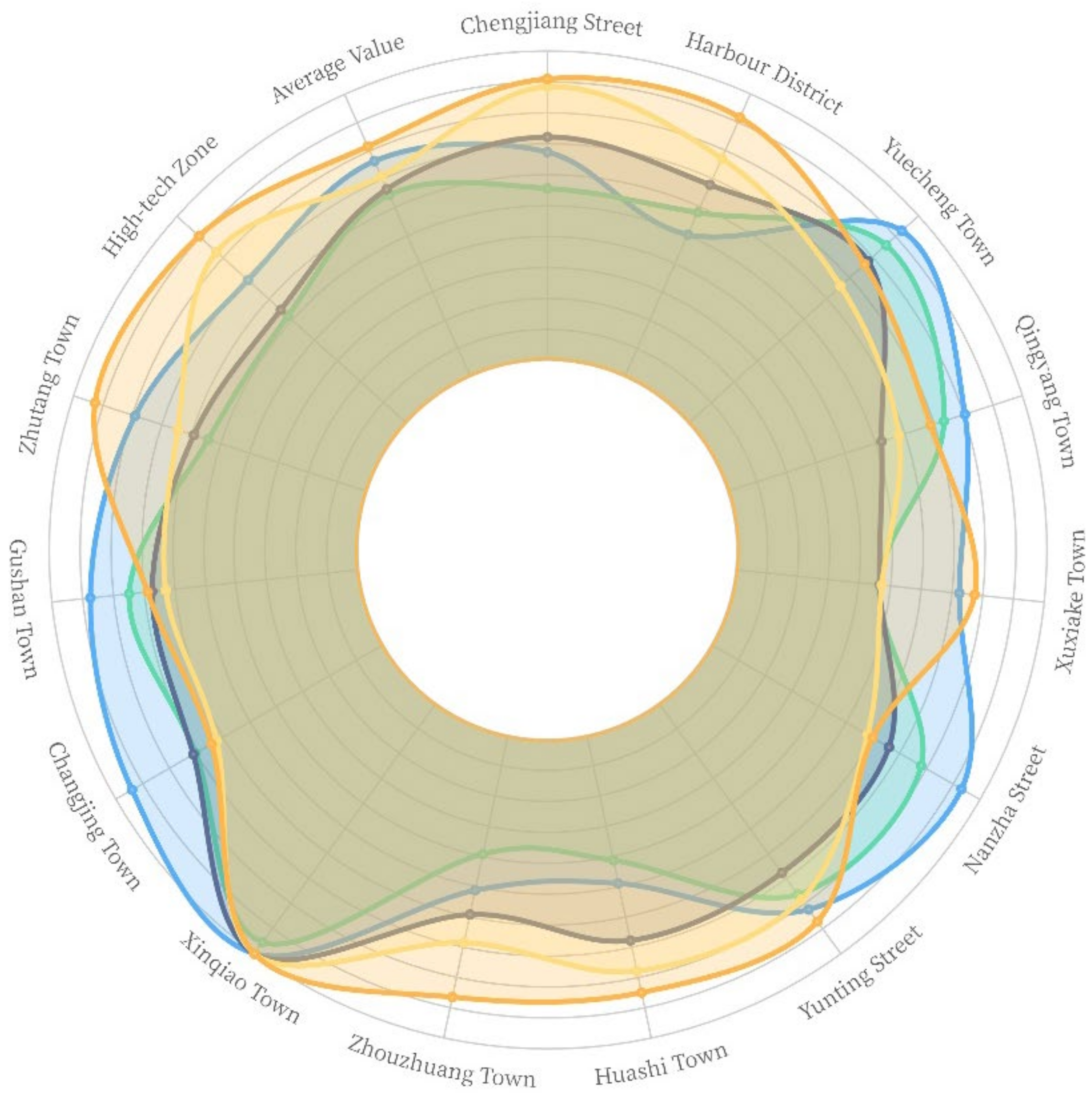
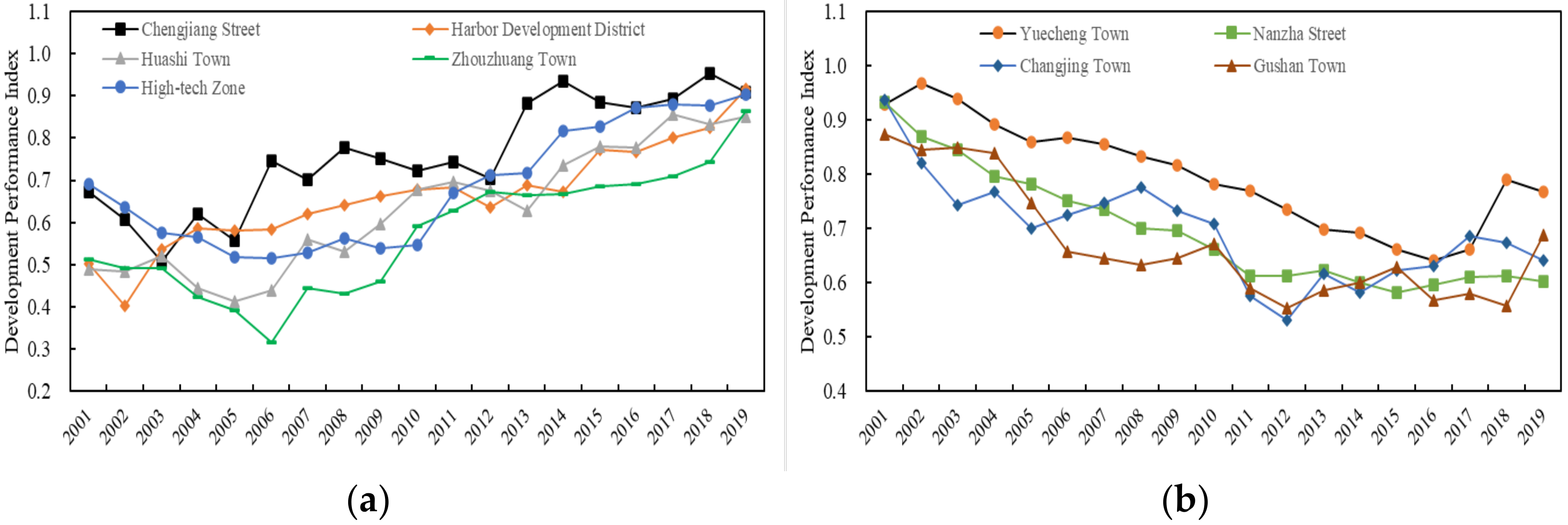
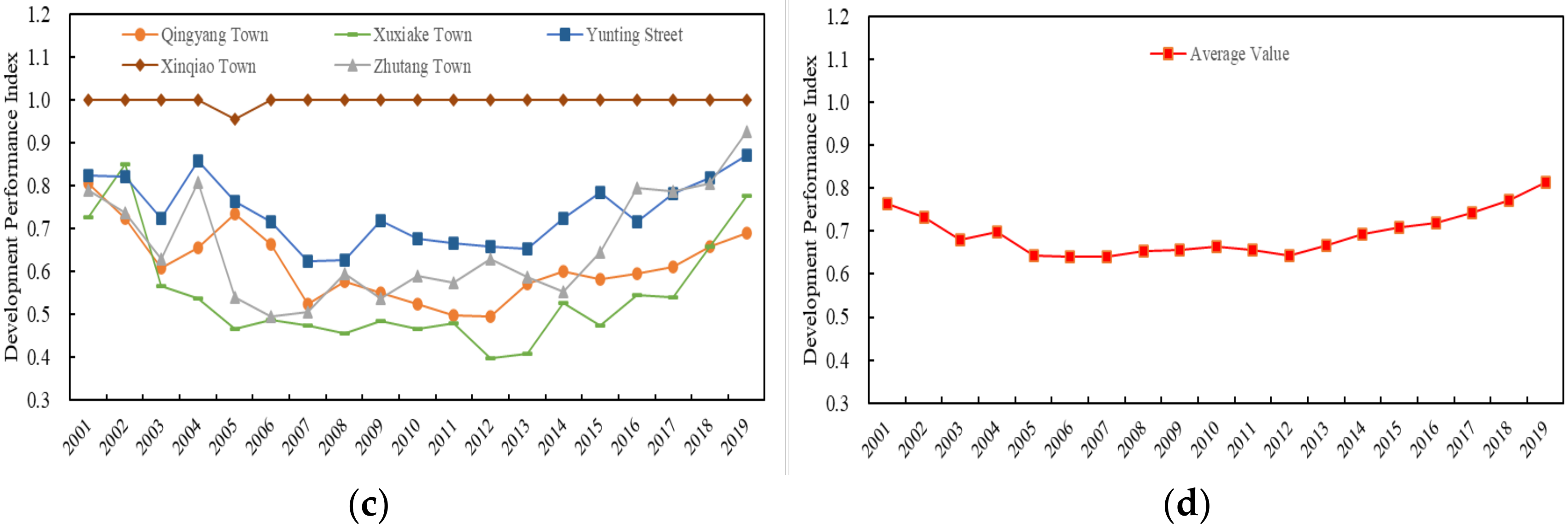
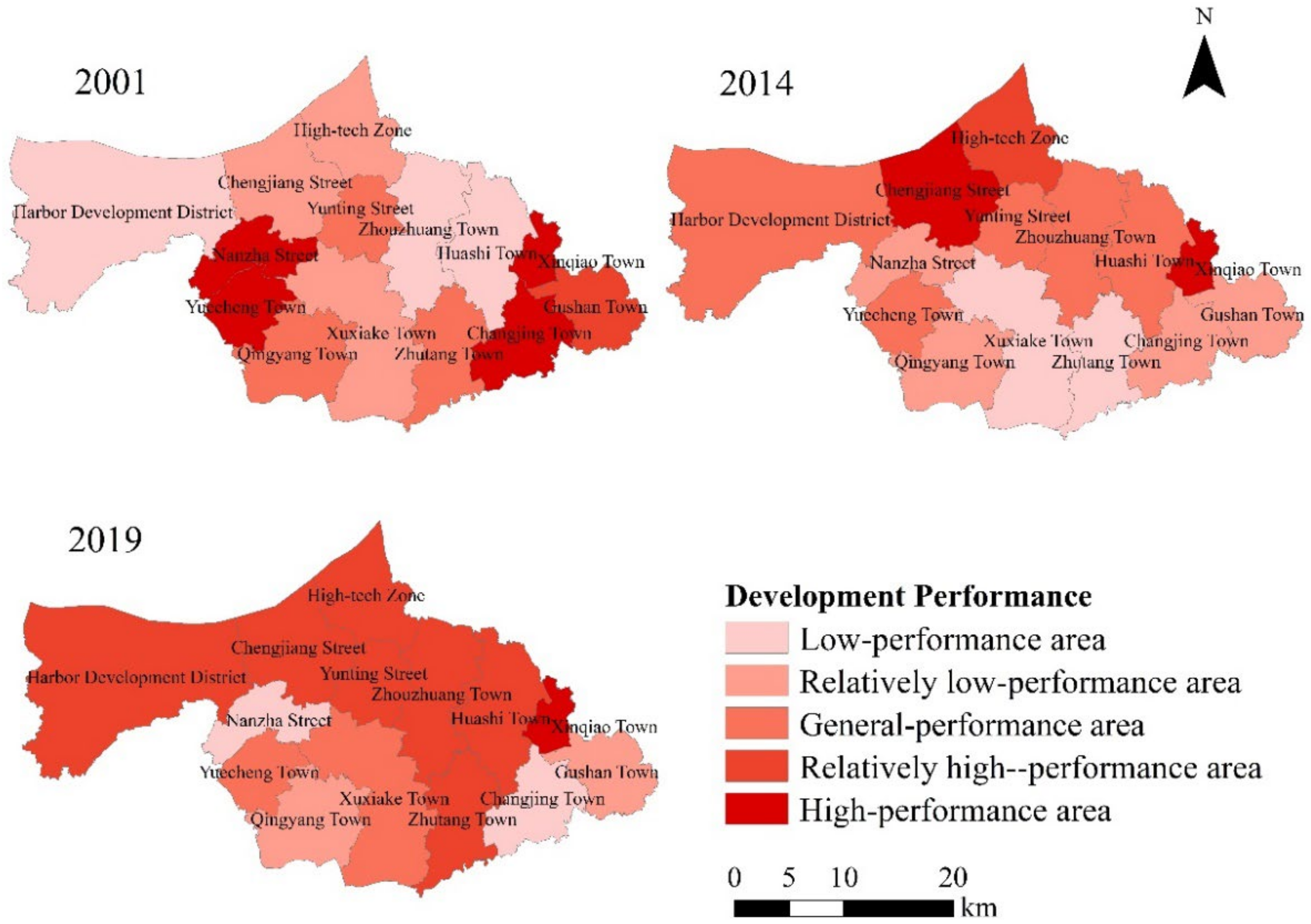
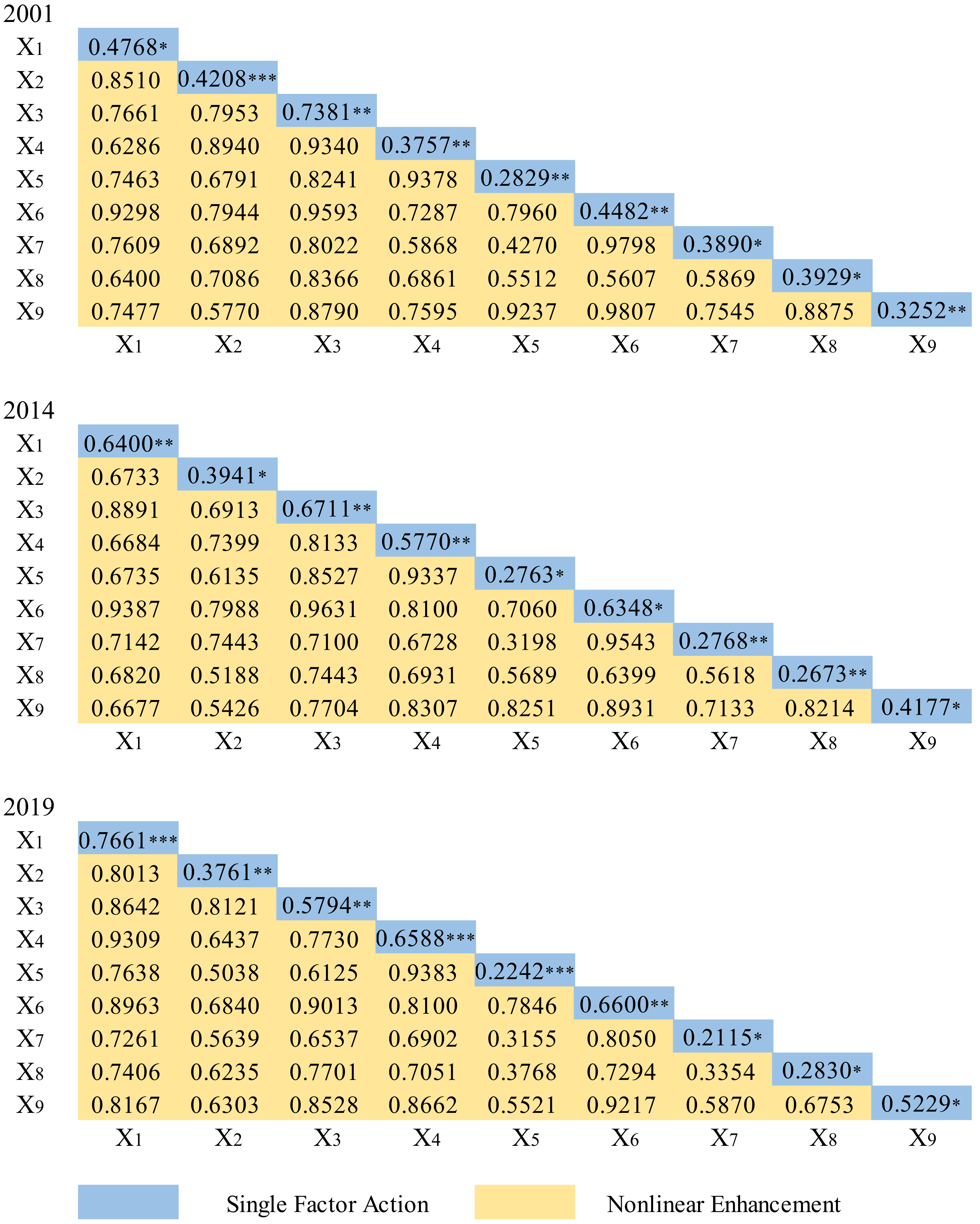
| The Data Name | Year | Data Description | Data Sources |
|---|---|---|---|
| DEM Data | 2019 | Digital elevation model with 30 m spatial resolution | https://www.resdc.cn/data.aspx?DATAID=217/ (last accessed on 8 July 2022) |
| Land-use Data | 2001 2014 2019 | Interpretation of remote sensing monitoring data at a 30 m spatial resolution | https://www.resdc.cn/Datalist1.aspx?FieldTyepID=1,3/ (last accessed on 8 July 2022) |
| River and Lake Datasets | 2019 | River and lake vector datasets | https://www.resdc.cn/Datalist1.aspx?FieldTyepID=1,3/ (last accessed on 8 July 2022) |
| Administrative Division Data | 2019 | Used to extract the study base map | https://www.resdc.cn/data.aspx?DATAID=203/ (last accessed on 8 July 2022) |
| NDVI Data | 2001–2019 | Maximum annual NDVI data at a 30 m spatial resolution | http://www.nesdc.org.cn/sdo/detail?id=60f68d757e28174f0e7d8d49/ (last accessed on 8 July 2022) |
| Statistical Yearbook Data | 2001–2019 | Demographic, industrial, social, and other statistics | Jiangyin Statistical Yearbook |
| System Layer | Subsystem | Indicators | Properties | Weight |
|---|---|---|---|---|
| Driving Force(D) | Economic development | Total investment in fixed assets (108 yuan) | Input indicator (+) | 0.10 |
| Social development | Year-end employed population (104 person) | Input indicator (+) | 0.08 | |
| Population growth rate (%) | Input indicator (+) | 0.14 | ||
| Pressure(P) | Resource stress | Year-end arable land (acre) | Input indicator (+) | 0.02 |
| Industrial electricity consumption (108 kWh) | Input indicator (−) | 0.06 | ||
| Status(S) | Investment and construction | Proportion of employees in the secondary industry (%) | Input indicator (−) | 0.04 |
| Proportion of employees in the tertiary industry (%) | Input indicator (+) | 0.05 | ||
| Influence (I) | Economic quality | GDP growth rate (%) | Output indicator (+) | 0.12 |
| Life quality | Per capita disposable income (yuan). | Output indicator (+) | 0.12 | |
| Response(R) | Industrial structure | The proportion of the secondary industry (%) | Output indicator (−) | 0.10 |
| Consumption mode | Per capita fixed asset stock (yuan) | Output indicator (+) | 0.08 | |
| Ecological resource | Comprehensive energy consumption of industrial enterprises above designated size (tons of standard coal/104 yuan) | Output indicator (−) | 0.07 | |
| NDVI index | Output indicator (+) | 0.02 |
| Influencing Factors | Detection Factors | Factor Interpretation | Unit |
|---|---|---|---|
| Economic factors | X1 GDP per capita | Gross regional product per capita | 104 Yuan |
| X2 Fiscal revenue | Net income from fiscal funds for the whole year | 108 Yuan | |
| X3 Industrial investment | Total annual industrial industry capital investment | 108 Yuan | |
| Social factors | X4 Total social electricity consumption | Sum of the annual electricity consumption of the whole society | 108 KWH |
| X5 Population density | Number of people in unit area | Person/km² | |
| X6 Construction land density | Scale of construction land in unit area | % | |
| Ecological factors | X7 Terrain elevation | Average elevation of terrain in the region | m |
| X8 River density | Length of the river in unit area | m/km² | |
| X9 Greenfield rate | Ratio of greenfield area to total land area | % |
| Influencing Factors | 2001 | 2014 | 2019 | |||
|---|---|---|---|---|---|---|
| qX,Y | qX,Y Ranking | qX,Y | qX,Y Ranking | qX,Y | qX,Y Ranking | |
| X1 | 0.4768 | 2 | 0.6400 | 2 | 0.7661 | 1 |
| X2 | 0.4208 | 4 | 0.3941 | 6 | 0.3761 | 6 |
| X3 | 0.7381 | 1 | 0.6711 | 1 | 0.5794 | 4 |
| X4 | 0.3757 | 7 | 0.5770 | 4 | 0.6588 | 3 |
| X5 | 0.2829 | 9 | 0.2763 | 8 | 0.2242 | 8 |
| X6 | 0.4482 | 3 | 0.6348 | 3 | 0.6600 | 2 |
| X7 | 0.3890 | 6 | 0.2768 | 7 | 0.2115 | 9 |
| X8 | 0.3929 | 5 | 0.2673 | 9 | 0.2830 | 7 |
| X9 | 0.3252 | 8 | 0.4177 | 5 | 0.5229 | 5 |
Publisher’s Note: MDPI stays neutral with regard to jurisdictional claims in published maps and institutional affiliations. |
© 2022 by the authors. Licensee MDPI, Basel, Switzerland. This article is an open access article distributed under the terms and conditions of the Creative Commons Attribution (CC BY) license (https://creativecommons.org/licenses/by/4.0/).
Share and Cite
Gong, X.; Zhang, X.; Tao, J.; Li, H.; Zhang, Y. An Evaluation of the Development Performance of Small County Towns and Its Influencing Factors: A Case Study of Small Towns in Jiangyin City in the Yangtze River Delta, China. Land 2022, 11, 1059. https://doi.org/10.3390/land11071059
Gong X, Zhang X, Tao J, Li H, Zhang Y. An Evaluation of the Development Performance of Small County Towns and Its Influencing Factors: A Case Study of Small Towns in Jiangyin City in the Yangtze River Delta, China. Land. 2022; 11(7):1059. https://doi.org/10.3390/land11071059
Chicago/Turabian StyleGong, Xiao, Xiaolin Zhang, Jieyi Tao, Hongbo Li, and Yunrui Zhang. 2022. "An Evaluation of the Development Performance of Small County Towns and Its Influencing Factors: A Case Study of Small Towns in Jiangyin City in the Yangtze River Delta, China" Land 11, no. 7: 1059. https://doi.org/10.3390/land11071059
APA StyleGong, X., Zhang, X., Tao, J., Li, H., & Zhang, Y. (2022). An Evaluation of the Development Performance of Small County Towns and Its Influencing Factors: A Case Study of Small Towns in Jiangyin City in the Yangtze River Delta, China. Land, 11(7), 1059. https://doi.org/10.3390/land11071059






